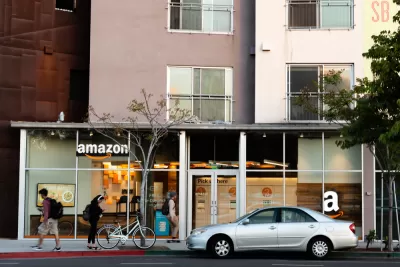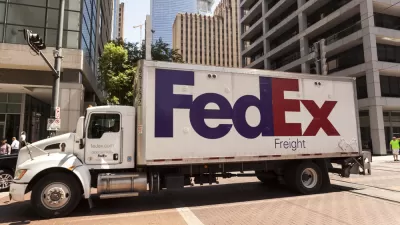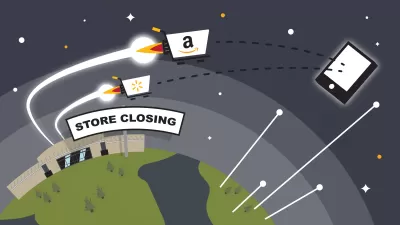The theoretical planning of smart cities could help make city economies stronger as purchasing becomes more straightforward.

When many officials plan smart cities, they discuss the economic benefits that should naturally occur once people realize a destination is a cutting-edge place to live or do business.
However, one aspect that is not always studied is how the combination of smart cities and connected fleets could make it easier for people to get things they need or want, allowing individuals to contribute more to the economy as purchasing becomes easier.
Connected Infrastructure Could Help People Get Their Goods Faster
The rise in online shopping allowed people to order almost anything without leaving home. As the e-commerce sector became more competitive, retailers realized efficiency would help stores or delivery services stand out.
Now, Walmart and Target offer same-day deliveries, emerging as direct competitors to Amazon, which provided ultra-fast deliveries earlier than the other two brands. Delivery services are also more specific with timeframes. DPD provides customers with two-hour windows for parcel arrivals. People who use the company’s app can see precisely how many stops remain until drivers reach their homes or businesses.
Land use changes could also be on the way. Amazon once operated on the outskirts of communities, typically using massive facilities. That's changing now. Sources say Amazon decision-makers plan to create 1,000 small delivery hubs in towns and cities across the United States. As connectivity levels increase and goods get closer to the people who buy them, online shopping could become virtually frictionless.
A recent study found that online shopping purchases increased by 6 to 10 percentage points across most product categories since the COVID-19 health threat emerged. Also, most respondents planned to keep buying things through the internet after the novel coronavirus gets under control. If someone lives in a connected city and sees real-time updates about the movement of recently purchased goods in transit, they may be more likely to buy more items due to the increased transparency.
Fleet Technologies May Help Overcome Logistics Obstacles
Smart cities sometimes become tourist hotspots, especially if visitors want to see what's possible when technology makes somewhere a more enjoyable place to live. However, the increased traffic from deliveries can cause frustrating levels of congestion.
In 2018, London's mayor launched a roadmap to make it "the smartest city in the world." London is already a popular tourist destination. Long before the efforts to make it more high-tech, city officials noticed that delivery traffic discouraged visitors. A 2008 study from a London landlord found delivery vehicles accounted for 35% of all peak-hour traffic in the Regent Street shopping district. After that, the area's retailers had to use a consolidation center, with one company handling deliveries.
Consolidation centers don't always create wholly favorable situations. The University of Newcastle had such a facility that cut pollution. However, it cost an extra £100,000 a year to run and ultimately shut down. This example shows that even when a city has the connected infrastructure to try different options, it is not always financially feasible.
There are other forward-thinking ways to manage backups, and it's vital to at least consider those options. One study found that 54% of truck drivers waste three to five hours during every visit to a loading dock. Using new technologies to get items on and off trucks could reduce those delays. Companies can also use geofencing technologies to receive alerts when a driver gets within a certain distance of a warehouse. Having that knowledge gives them more time to prepare.
Companies are working with technologies like robots and e-bikes to deliver goods through more efficient, greener methods. However, it's too early to tell if the adoption of these alternatives will be widespread enough to make a major difference, whether in smart cities or less advanced ones.
Updated Vending Machines Give People More Purchasing Options
Logistics difficulties are especially likely in cities with centuries of history. Then, even the best efforts to improve those places could fall short due to old infrastructure.
Bettina Tratz-Ryan is a German-based Gartner analyst who researches intelligent urban ecosystems. As she points out, "Last-mile logistics innovation in Europe differs from that of the U.S. in that European cities often have aging infrastructure that goes back to medieval times. Here, the focus is on finding solutions that utilize smaller delivery form factors with lower emissions because of the lack of parking spaces for urban delivery and a larger focus on climate issues." Tratz-Ryan gave examples of hand carts, bicycles, and parcel lockers connected to mobile apps.
Elsewhere, city officials strategically placed vending machines to give people more ways to purchase during COVID-19 lockdowns. Those let people approach on foot to buy items immediately, thereby removing issues associated with delivery trucks. Carlton, a suburb of Melbourne, Australia, installed one that dispensed everything from books to winery vouchers, with new supplies added daily. The machine helped small businesses continue to profit, even once lockdowns took effect.
Major companies operating vending machines as significant parts of their business connect them to their fleet management technology, too. Coca-Cola and its vendors use facial tech to tell which devices get the most traffic and which drinks sell fastest. Then, restocking professionals know which beverages to bring. These machines also offer cashless payments, helping people quench their thirst without pocket change.
Someday, those benefits could extend to consumers, too. Many vending machines now sell high-end merchandise, like electronics. Someone might use an app to determine which products are in the dispensers closest to them.
A Hopeful but Still Uncertain Future
As cities become more connected, they'll likely include more fleet technologies. Nevertheless, it's still too early to know how those implementations might boost economies.
Since many logistics companies are testing their new technologies, entities may encounter challenges that reveal how smarter is not always better. Smart cities may solve some logistical and economic problems, but people should not automatically assume they'll fix all of them.

Alabama: Trump Terminates Settlements for Black Communities Harmed By Raw Sewage
Trump deemed the landmark civil rights agreement “illegal DEI and environmental justice policy.”

Study: Maui’s Plan to Convert Vacation Rentals to Long-Term Housing Could Cause Nearly $1 Billion Economic Loss
The plan would reduce visitor accommodation by 25% resulting in 1,900 jobs lost.

Planetizen Federal Action Tracker
A weekly monitor of how Trump’s orders and actions are impacting planners and planning in America.

Grand Rapids Mayor Proposes Garage Conversion Plan
The mayor says allowing homeowners to convert garages to dwelling units could alleviate the city’s housing shortage.

Baltimore Ordered to Improve Sidewalk Accessibility
The city is one of many to face lawsuits for failing to comply with the Americans with Disabilities Act.

This Toronto Suburb Has More Bus Riders Than Columbus, Ohio
Brampton, Ontario used gradual improvements in service to prove that if you build it, they will ride.
Urban Design for Planners 1: Software Tools
This six-course series explores essential urban design concepts using open source software and equips planners with the tools they need to participate fully in the urban design process.
Planning for Universal Design
Learn the tools for implementing Universal Design in planning regulations.
Smith Gee Studio
Alamo Area Metropolitan Planning Organization
City of Santa Clarita
Institute for Housing and Urban Development Studies (IHS)
City of Grandview
Harvard GSD Executive Education
Toledo-Lucas County Plan Commissions
Salt Lake City
NYU Wagner Graduate School of Public Service






























